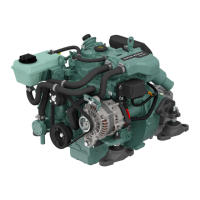•
Charge batteries if they have become discharged.
During charging, unscrew the cell plugs but leave
them in the plug holes. Ventilate well, especially if
the batteries are charged in an enclosed space.
•
If the engine is not used for a longer period of time,
the batteries should be fully charged, then possibly
trickle charged (please refer to the battery manu-
facturer’s recommendations). Batteries are dam-
aged by being left discharged, and can also freeze
and burst easier in cold weather.
•
Special instructions apply to boost charging. Boost
charging can shorten battery life, and should there-
fore be avoided.
Electrical Installations
An incorrectly-carried-out electrical installation may
generate leakage current from the electrical system.
Leakage current can in turn render galvanic protection
inadequate in respect of propellers, propeller shafts,
rudder posts, the keel etc., and may cause damage
through electrochemical corrosion.
WARNING!
Work on the low voltage circuits in the boats should be
done by a person with electrical training or knowledge.
Installation or work on land current equipment must
only be done by a competent electrician, in accordance
with local regulations for mains electricity.
Maintenance
47702088 05-2011 55
47702088 - Downloaded from www.volvopenta.com 02/06/2011 18:54:55

